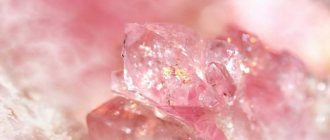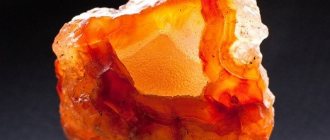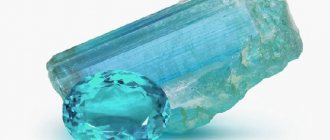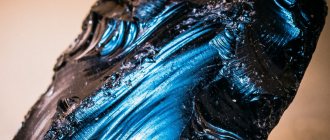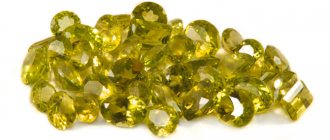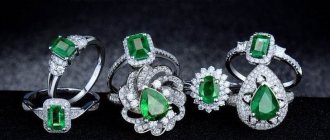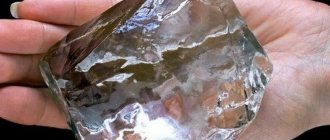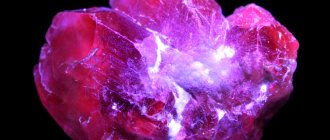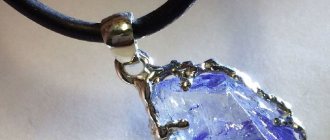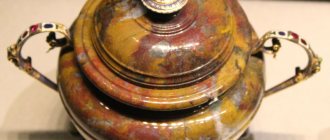This amazingly beautiful and very rare gem was discovered only in 1987. Paraiba is a truly precious stone, because one carat costs at least 10 thousand dollars.
The greenish-blue gem does not cast a shadow even on a sunny day. Instead, a neon glow appears, emanating from the stone.
History and origin of the name
The stone was originally called heiterite in honor of its discoverer.
In Brazil, illegal treasure miners are called "garimpeiros." One of them, Hayter Barbosa, had the honor of finding a new gem. This was no ordinary garimpeiros. He did not thirst for profit, like everyone else. He was driven by the dream of finding something that would glorify Brazil.
Having purchased a license to search for precious stones in the easternmost Brazilian state of Paraibo, he, along with a group of the same prospectors, practically did not leave the adits of an abandoned mine near the village of São José da Batalha for five years, sifting through tens of tons of rocks in the hope of finding something quite unusual.
His dream came true in 1987, when Barbosa himself was already terminally ill. During excavations of a 60-meter-high hill, a strikingly beautiful tourmaline was discovered, glowing from the inside with blue neon light. Hayter himself missed the triumphant exhibition in the Arizona city of Tucson, where the price of the new gem increased tenfold in a matter of days.
And yet, for some reason, the name “hayterite” did not stick, and the stone was called “Paraiba” after the name of the Brazilian state where it was first found. In general, it turned out as Hayter dreamed, who glorified his country with his find.
Paraiba Tourmaline
| Thardness on the Mohs scale: 7 – 7,5 Density: 3.06 (+0.20, -0.06) g/cm3 Gloss: glass Refractive index: 1,624 – 1,644 Birefringence: 0,018 – 0,040 Dispersion: 0,017 Color: light blue, greenish blue, blue, violet blue Syngony : trigonal Optical character: anisotropic Cleavage: none |
One of the most beautiful stones on the planet, Paraiba tourmaline was first mined in Brazil in 1987, near the village of São José de Batalha. An unprecedented gem shocked the global jewelry community.
The Brazilian prospector Heitor Dimas Barbos was the first to begin excavations in the Paraiba hills. He was convinced that these places concealed treasures unknown to mankind, and he was right. Five years later, his team discovered sky-blue tourmalines with incredible glassy luster and an internal glow. Unfortunately, Heitor Dimas himself did not see the dizzying success of the found stones - by the time they were discovered, he was mortally ill and soon died. However, he will always have the championship in the discovery of some of the most beautiful gems on Earth.
Paraiba was first presented at the Tucson Fall Gem Shows in the USA. Jewelry houses were so amazed by the beauty of the stone that they immediately began ordering its supply. Very soon the mineral began to cost fabulous money.
The supply of Brazilian tourmalines quickly depleted: the only known deposit - a hill 65 meters high - was quickly razed to the ground. Fortunately, in 2001, Paraiba was found in Nigeria, and 3 years later - in Mozambique. So the history of mining this incredible stone was able to continue.
The scattering of deposits of this type of minerals is associated with long-term geological changes. Once upon a time, these stones were formed at the same time and under the same conditions, next door, on the ancient continent of Pangea, which 150 million years ago split into the continents we know today. So some of the deposits remained in South America, and some ended up overseas - along with Africa and Madagascar.
Each deposit has its own characteristics:
- Brazilian stones are valued for the most saturated color;
- Paraiba from Nigeria is famous for its very large size, but has a rather pale color;
- Minerals from Mozambique are of amazing quality and color; today they are valued as much, if not more, than anyone else.
The US Gemological Association designates high-quality stones from Mozambique as Paraiba-type, which indicates the high similarity of these minerals to Brazilian ones. These are the best Paraiba tourmalines today, since Brazilian deposits have been depleted.
One of the interesting features of tourmalines is the polarization of light. This is the refraction of a light ray by a stone, as a result of which the glow intensifies several times. In the case of Paraiba tourmaline, this effect causes its internal neon glow, from which it is impossible to look away.
The unusual shade of Paraiba is obtained due to the content of copper and manganese in it, and other types of tourmalines acquire characteristic colors due to iron, vanadium, chromium and other substances. Knowledge about the content of many chemical elements in tourmaline allowed jewelers to improve its beauty. So, in order to make the color of Paraiba even more saturated and pure, it is heated, thereby removing excess impurities in the stone. As a result, we can observe products of extraordinary beauty.
Place of Birth
The hill where the unusual mineral was found was torn down very quickly, since the price per carat was ten times higher than that of diamonds. Quite a lot of stones were mined, but the largest of them did not exceed 8 carats.
After the first deposit was depleted in 2001, similar gems were found in Nigeria, and then in Mozambique, Tanzania and Madagascar. But African gems were significantly inferior to Brazilian ones in terms of jewelry quality, differing from them in shades and intensity of glow. Until now, jewelers do not recognize them as real Paraiba, and their price is ten times less.
Despite this difference, the composition of stones from different shores of the Atlantic is almost identical, and the age of the gems is the same, since they were formed about 500 million years ago in the depths of the ancient continent of Pangea. Pangea later split into several parts, now separated by thousands of kilometers of ocean.
But recently, already in the 21st century, it was possible to find another deposit in Brazil, but in a different state of Rio Grande do Norte. Their quality was the same as those opened by Hayter. Since then, only the Brazilians call it “paraiba”, while the African ones only call it “paraiba type”.
Where is it used?
The value of the stone determined the areas of application:
- Investment object. The cost of Paraiba grows every year. The less raw materials remain in the deposits, the faster the price rise process (+20-30% annually). Even stones from Africa are suitable, not to mention real Brazilian ones.
- Jewelry. Blue or turquoise stone goes well with gold and platinum.
Ring with Paraiba tourmaline
Earrings, a pendant, a ring, a ring with Paraiba tourmaline will immediately indicate the status of the owner.
- Collecting. Raw samples from various mines on the planet are a worthy goal for a collector. And also a reliable investment.
In all cases, you need to carefully study the accompanying documents for the stone so as not to buy a fake.
Physical properties
Paraiba is a variety of tourmaline and has the same physical properties. Their shine is glassy. The refractive index is close to glass (1.62-1.65), and the density is 3.2 g/cm3. The hardness is quite high and ranges from 7 to 7.5. The color can be sky blue or greenish blue. In African stones, a green tint is much more common, as are pink or purple.
The glow of Paraiba is due to the property of tourmalines to polarize passing light. As a result of multiple reflections of polarized rays, a magical glow is born.
Interesting: Paraiba, like other tourmalines, exhibits piezo- and pyroelectric effects, that is, the ability to acquire a potential difference at the ends of the crystal under the influence of deformation and heating.
Mining and stone processing
Depending on the component composition and textures, numerous mineral types of apatite ores are distinguished: apatite nepheline, silicate, ilmenite-titanomagnetite (see ilmenite), magnetite, carbonate. The nature of the desired apatite depends on the type of ore.
Apatite ores are mined in various parts of the vast planet. In each place, rock deposits are unique and have unique properties:
- In Russia and Finland, mainly blue and green minerals are mined.
- Yellow, brownish gems from Mexico, Canada.
- Myanmar, Sri Lanka - with a cat's eye effect.
- Pink gems are from the Pamirs and the Baikal mountains.
- Violet, colorless apatites - in the North of Europe and Italy.
- Canada and India are characterized by only green samples.
- Stones from Norway are particularly beautiful. The shade of sea wave prevails in them; the stones themselves are transparent and have a pattern that can be seen even from the inside.
Stone processing requires great care from the jeweler. It has low hardness, so it is rarely used in jewelry making. But if a master takes on the task of making jewelry with apatite, then he uses miniature-sized specimens.
The largest stone in the finished product is only 5 carats.
Chemical properties and composition
In terms of its chemical composition, Paraiba is a boron- and fluorine-containing aluminosilicate. Its color is given by numerous impurities, primarily copper and manganese, and it is copper that provides the sky-blue color of the stone, and manganese spoils it, imparting pink and purple tones, as in the African “Paraiba type”. Copper in a quality stone should be at least 1.2%. In total, about 50 elements were found in Paraiba. This is one of the richest gems in composition.
Paraiba is quite resistant to acids and alkalis. Only molten alkalis are capable of dissolving it, and even then very slowly. But the color and glow may change from contact with chemicals. They are determined by very subtle ratios of the components included in the stone.
Who is suitable according to their zodiac sign?
Paraiba tourmalines are suitable for all zodiac signs. The properties of these gems appear depending on their belonging to the zodiac element:
- Pisces, Cancers and Scorpios are considered favorites of this stone. It helps representatives of these signs curb their emotions, become more restrained and balanced.
- Virgos, Capricorns and Taurus can use paraiba for medicinal purposes, to relieve physical and emotional fatigue.
- Leos, Sagittarius and Aries will receive an inexhaustible supply of energy and inspiration from the mineral.
- With the help of the stone, Libra, Aquarius and Gemini will be able to reveal their creative talent and hidden abilities.
When choosing Paraiba tourmaline as a talisman or amulet, you should be guided by your own feelings. If during contact with the stone you feel a surge of strength and your mood improves, then it is energetically suitable.
Artificial paraiba
As soon as the price of Paraiba exceeded $10,000 per carat, attempts to counterfeit the gem became more frequent. This turned out to be a very difficult task. It is possible to obtain a neon glow throughout the entire volume of a transparent stone only if there is a sufficient copper content inside it. They tried to saturate the surface layer with copper, but such fakes were immediately noticeable by the nature of the glow.
There have been attempts to produce sky blue from purple or pink Africans by heating. The color came out, but the shine disappeared. Great results were achieved by those who combined the heating of indigolites in acids with harsh gamma irradiation. Such stones can only be distinguished by chemical analysis.
The only way to get an analogue was to fire copper atoms at an accelerator, but this is already exotic, although raising the price a little more would pay off.
The Swarovski company also makes similar ones to Paraiba, but the composition of the crystals is completely different; they are glass-ceramics. Despite the great similarity to natural Paraiba, according to esotericists, such counterfeits do not have magical or healing properties.
Types of stone
After the discovery of African deposits, luminous tourmaline was divided into subgroups.
Also read: Belomorite - the magical and healing capabilities of the mineral
The most valuable and pure stones are considered to be gems from Brazilian mines. These minerals are in demand in jewelry production and are valued at the highest category. The price for 1 carat of such a stone reaches 20 thousand US dollars.
Gems mined in African deposits were given the name Paraiba Type, which literally means “Paraiba Type”. To ensure blue tourmaline matches the Brazilian gem, African jewelers apply high temperatures to the stones. After this treatment, the mineral acquires a natural turquoise hue characteristic of Paraiba, but the internal glow of the stone disappears.
Reference! Modern technologies make it possible to create analogues of the Brazilian gem from various varieties of tourmaline. Most often, purple or green crystals are used to make fakes.
How to spot a fake
Even an experienced jeweler will have difficulty distinguishing a particularly high-quality fake. There are also Swarovski crystals with the right neon glow. They are as hard as natural stone and cannot be scratched by a key. But you can try to scratch cheap glass fakes. If the jeweler is afraid of such a procedure, then this is a sure sign that he is trying to pass one thing off as another.
With a needle you can also check a gem that has been heated in acid, following the greenish trace.
Decorations
Every piece of jewelry with Paraiba tourmaline is doomed to success. World-famous jewelry houses such as Dior, Tiffany, Spark Creations, etc. know this and actively use it. Jewelry with a famous gem looks great framed in yellow or white gold and in combination with diamonds, as well as colorful precious stones, such as sapphires or emeralds.
Tiffany
Tiffany & Co has exclusive purchasing authority for all neon gems over 3 carats. She bought more than 70% of Paraiba tourmalines, and then organized a project to promote her jewelry with this stone and in 5 years had already earned more than 100 million US dollars.
The natural gemstone Paraiba tourmaline is used only in luxury jewelry, often created in a single copy to order, and is sold at exorbitant prices. But it is worth it, which becomes obvious at one glance at its magical hypnotic glow and unique heavenly purity.
Review of Paraiba tourmaline at the exhibition:
Magic properties
Paraiba is credited with the magical property of relieving feelings of melancholy and anxiety. This stone helps to find your soulmate, protects against negative energy, and gives interesting ideas to creative people. It relieves fatigue and gives confidence in one's own abilities.
Paraiba is useful for all those who experience constant stress and nervous overload, or suffer from troubles in the family, as it has a calming effect.
Compatibility with names and zodiac signs
Each zodiac sign is characterized by unique character and personality traits. But we will look further into how compatible Paraiba is with this or that sign.
- For energetic and impulsive Aries, the gem will help them find restraint and calm.
- For Taurus, the stone stimulates the development of patience and perseverance.
- For Gemini, the mineral helps protect their health from various diseases.
- The gem will help Cancers avoid depression and nervous disorders.
- But the luminous mineral will protect Lviv from the negative effects of the environment.
- For those born under the sign of Virgo, a turquoise gem is not suitable.
- Libras with Paraiba jewelry will feel confident.
- In the presence of such jewelry, Scorpios show attractiveness and sexuality.
- For Sagittarius, the gem acts as a healer, replenishes energy, and supports the immune system.
- For self-confident Capricorns, the Paraiba mineral will become a serious obstacle to achieving their goals.
- Aquarians are by nature modest, insecure people. A precious crystal will help you reveal new abilities of your character.
- But the mineral will protect Pisces from possible failures and troubles.
Also read: Opal – a stone of talent and charisma
Also, there are names on which the gem has the most positive effect:
- Women with the names Sofia, Veronica, Yulia, Tatyana and Olga with jewelry from Paraiba will always be the center of attention.
- For men with the names Andrey, Leonid, Vitaly or Eduard, cufflinks or rings with the mineral will help them achieve success in any area of life.
Important! The gem is capable of both replenishing the energy of the human aura and absorbing it. Therefore, at the slightest discomfort, jewelry should be removed and washed in running water.
Ring with Paraib
Is this stone right for you?
Medicinal properties
This neon glowing stone is believed to be:
- Normalizes blood pressure;
- Improves the functioning of the endocrine system;
- Cures women's diseases;
- Calms the nervous system;
- Protects against ARVI;
- Slows down aging.
ATTENTION: The stone is contraindicated for diseases of the thyroid gland. It should be worn with caution if you are pregnant or breastfeeding, or if you have a fever. Signs of incompatibility are sudden weakness and melancholy when wearing the stone.
Description, production
Paraiba is the most valuable variety of tourmaline, which belongs to the group of aluminum silicates, where in addition to standard impurities there are traces of gold, which makes the gem unique in its chemical composition. The mined crystals have a unique purity and do not contain adhesions, which makes the mineral very fragile. However, despite this, Paraiba has high hardness and can even scratch quartz or glass.
The shade of the stone is bright turquoise with a blue or green neon tint. Any lighting - natural or artificial - creates incredible shine. In addition, in sunlight the gem does not leave a shadow, which indicates a high level of transparency and purity. It is noteworthy that the brilliance of the mineral does not decrease at dusk. It seems to shine from within with a bright, rich glow.
The Paraiba deposits are still vigorously discussed among the most famous jewelry brands. Since the stone was originally found in Brazil, many jewelers accept only this deposit - the state of Paraiba, denying other parts of the world. So, after such enormous popularity, a few years later, similar crystals were found in Southeast Africa and on the island of Madagascar, and a little later - in Nigeria. But large jewelry companies only accept Brazilian items. They call others indigolites and “Paraiba-type stones.”
Story
The gem is unique not only for its properties and chic shade. Its discovery story deserves special attention.
In the state of Paraiba there lived a miner named Heitor Barbosa, who for a very long time dreamed of glorifying the city in which he was born. He was unlucky for a very long time, and only in 1982 did his intuition lead him to an abandoned and depleted mine, where his dream came true, but only five years later. Examining the river opening centimeter by centimeter, a mineral of incredible color was discovered. Unfortunately, when Paraiba was recognized as a separate stone, its discoverer was already old and near death. Initially, it was given the name “heiterite” (in honor of Barboz), but this name did not take root.
Properties
Like any other stone of natural origin, the gem has unique healing and magical properties.
Healing
The mineral has the following healing properties:
- normalizes blood pressure, stabilizes blood flow in blood vessels;
- improves the functioning of hormones, improving overall hormonal levels;
- reduces the risk of infertility, treats female diseases and improves the functioning of the reproductive system;
- calms the nervous system, stabilizes emotions, reduces feelings of unreasonable anxiety, improves mental state in general;
- improves the functioning of the immune system, treats colds and flu.
- relieves insomnia and nightmares;
- improves appetite;
- improves metabolism.
However, there are diseases for which wearing Paraiba is not recommended:
- presence of a pacemaker;
- abnormalities in the functioning of the thyroid gland;
- heat;
- allergy;
- cuts, abrasions, soft tissue injuries.
Among other things, the stone slows down the aging process and treats kidney and liver diseases.
Magical
Experts in the field of magic classify the gem shade as one of those responsible for spiritual development and energy. They also claim that the mineral can help with the following:
- cleanses the aura and protects against damage, the evil eye, curses and other negative influences;
- helps you find inner harmony with yourself;
- gives men self-confidence, strength and courage;
- drives away bad thoughts, prevents resorting to lies and gossip;
- helps develop creativity and talents;
- develop honesty, determination and love of life in the owner.
However, experts are confident that the Paraiba needs to be periodically cleansed of energy negativity so that it does not act in the exact opposite way.
Paraiba products
Paraiba is set into brooches, pendants and earrings, often surrounded by diamonds to highlight its blue radiance. All the richness of the glow can be seen in white gold rings.
Such a ring can cost up to hundreds of thousands of dollars or even more.
Interesting: The most expensive Paraiba was sold for $125 million and entered the Guinness Book of Records.
Interesting things about the stone
To arouse even greater interest in the rare gem, we suggest that you familiarize yourself with interesting facts.
- After the first jewelry exhibition, where a new type of gems was presented, the famous jewelry manufacturer TIFFANI offered the Brazilians a multi-year contract. The agreement for the exclusive purchase of minerals exceeding the 3-carat mark is still in effect.
- According to statistics, for every 10-15 thousand diamonds there is one Paraiba gem exceeding 1 carat in size.
- Paraiba is the only gem on the planet that contains gold particles.
The maximum size of the crystal found is more than 190 carats. The crystal was named Ethereal Carolina Divine, and was purchased by a famous jewelry company. Subsequently, the gem was included in the Guinness Book of Records and was used to create a necklace.
Stone care
Paraiba is washed only with warm running clean water. The use of any chemicals is unacceptable.
Store separately from diamonds, rubies and sapphires, which can scratch Paraiba.
Staying in sunlight causes the glow to decrease.
This stone is not available to every fashionista; it is not for nothing that the paparazzi sometimes hunt for stars just to look at Paraiba jewelry. Even those who can afford to purchase diamonds can buy African “Paraiba-type” diamonds. But the stone is worth it!
